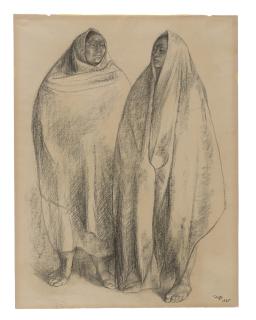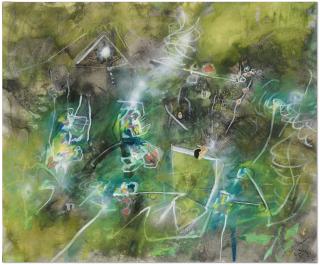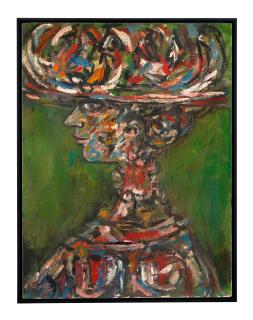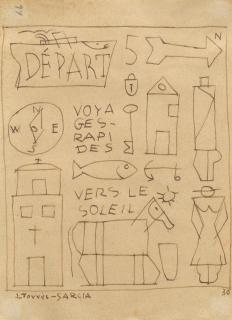Francisco Zúñiga 1912 - 1998
The artist Francisco Zúñiga
- Sculptor and painter who was known for his sometimes life-size sculptures of women.
- His art contributed significantly to a change in sculpture in Mexico at the time.
- Taught directly after his studies at the La Esmeralda Art Academy in Mexico City.
Francisco Zúñiga Chavarría, born 27 December 1912 in Guadalupe, San José Province, Costa Rica, deceased 9 August 1998 in Mexico City, was a Costa Rican-Mexican sculptor and painter known mainly for his multifaceted, sometimes life-size sculptures of indigenous women of Central America. In most cases, Zúñiga's sculptures and paintings focus on the naturalistic depiction of the female body - his figures are sometimes naked, sometimes wrapped in robes, sometimes squatting, sometimes standing or pensively leaning their heads in their hands.
He also has the women appear not only individually, but repeatedly in groups or as mothers of small children. Zúñiga's turn towards a realistic aesthetic is manifested not only in the often corpulent stature, but also in the introspective, serious facial expressions of the sculptures and paintings. It is said that his work was decisively responsible for a change in Mexican sculpture at the time.
Zúñiga grew up as the son of a religious painter and sculptor in the province of San José in Costa Rica. In 1927, at the age of 15, he took his first drawing lessons at the local art school. His points of contact with sculpture became apparent early on: between 1928 and 1934 he worked as an assistant in his own family business, his father's sculpture workshop. In 1935, he was awarded the prize of the Costa Rican art salon Salón de Escultura for his stone sculpture La Maternidad. A year later, Zúñiga decided to emigrate to Mexico, further north, because he was impressed by the landscape.
In Mexico he studied design and sculpture with Rodríguez Lozano and Oliverio Martínez. The contacts, his talent and his well-founded education enabled him to subsequently teach at the La Esmeralda Art Academy in Mexico City. From 1946 he worked exclusively as an artist. In 1958, he received the first prize for sculpture from the Instituto Nacional de Bellas Artes. Some thirty years later, in 1987, he became a member of the art institution Academia de Artes in Mexico City. Zúñiga died in 1998 at the age of 85 in his adopted country.
Der Künstler Francisco Zúñiga
- Bildhauer und Maler, der für seine teils lebensgroßen Frauenskulpturen bekannt war.
- Seine Kunst trug maßgeblich zu einer Veränderung der Bildhauerei in Mexiko bei.
- Unterrichtete an der Kunstakademie La Esmeralda in Mexiko-Stadt.
Francisco Zúñiga Chavarría, geb. 27.12.1912 in Guadalupe, Provinz San José, Costa Rica, gest. 09.08.1998 in Mexiko-Stadt, war ein costa-ricanisch-mexikanischer Bildhauer und Maler, der hauptsächlich für seine vielgestaltigen, teils lebensgroßen Skulpturen indigener Frauen Zentralamerikas bekannt war. Zúñigas Skulpturen und Gemälde fokussieren sich in den meisten Fällen auf die naturalistische Abbildung des weiblichen Körpers – seine Figuren zeigen sich mal nackt, mal in Gewänder gehüllt, mal hockend, mal stehend oder nachdenklich mit dem Kopf in die Hände gestützt.
Außerdem lässt er die Frauen nicht nur einzeln, sondern wiederholt auch in Gruppen oder als Mütter von kleinen Kindern in Erscheinung treten. Zúñigas Hinwendung zu einer wirklichkeitsnahen Ästhetik manifestiert sich nicht nur in der oftmals korpulenten Statur, sondern auch in der in sich gekehrten, ernsten Mimik der Skulpturen und Gemälde. Es heißt, dass seine Arbeit maßgeblich für eine Veränderung der damaligen mexikanischen Bildhauerei mitverantwortlich war.
Zúñiga wuchs als Sohn eines religiösen Malers und Bildhauers in der Provinz San José in Costa Rica auf. 1927, im Alter von 15 Jahren, nahm er an der örtlichen Kunstschule erstmals Zeichenunterricht. Seine Berührungspunkte zur Bildhauerei zeichneten sich schon früh ab. Zwischen 1928 und 1934 arbeitete er als Hilfskraft im eigenen Familienbetrieb, der Bildhauerei seines Vaters. 1935 wurde er mit dem Preis des costa-ricanischen Kunstsalons Salón de Escultura für seine Steinskulptur La Maternidad ausgezeichnet.
Ein Jahr später entschied sich Zúñiga ins nördlicher gelegene Mexiko auszuwandern, weil ihm die Landschaft imponierte. In Mexiko studierte er Gestaltung und Bildhauerei bei Rodríguez Lozano und Oliverio Martínez. Die Kontakte, sein Talent und seine fundierte Ausbildung ermöglichten es ihm, im Anschluss an der Kunstakademie La Esmeralda in Mexiko-Stadt in der Lehre tätig zu werden. Ab 1946 arbeitete er ausschließlich als freier Künstler. 1987 wurde Zúñiga Mitglied der kunstwissenschaftlichen Institution Academia de Artes in Mexiko-Stadt. Zúñiga starb 1998 im Alter von 85 Jahren in seiner Wahlheimat.



















![Francisco Zúñiga - Desnudo de Hombre [Male Nude]](/images/francisco-zuniga_desnudo-de-hombre-male-nude_AID1163239_320x320.jpg)


















